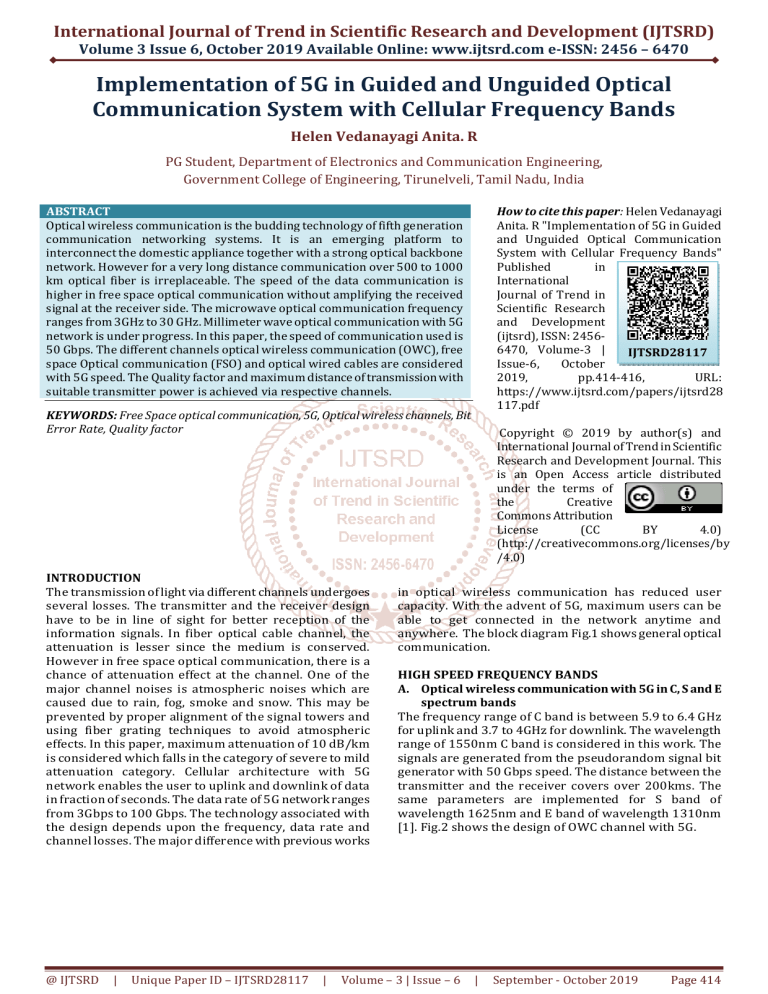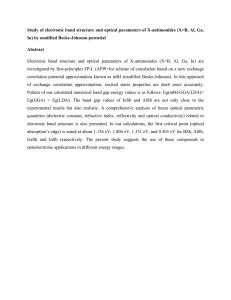
International Journal of Trend in Scientific Research and Development (IJTSRD)
Volume 3 Issue 6, October 2019 Available Online: www.ijtsrd.com e-ISSN: 2456 – 6470
Implementation of 5G in Guided and Unguided Optical
Communication System with Cellular Frequency Bands
Helen Vedanayagi Anita. R
PG Student, Department of Electronics and Communication Engineering,
Government College of Engineering, Tirunelveli, Tamil Nadu, India
How to cite this paper: Helen Vedanayagi
Anita. R "Implementation of 5G in Guided
and Unguided Optical Communication
System with Cellular Frequency Bands"
Published
in
International
Journal of Trend in
Scientific Research
and Development
(ijtsrd), ISSN: 24566470, Volume-3 |
IJTSRD28117
Issue-6,
October
2019,
pp.414-416,
URL:
https://www.ijtsrd.com/papers/ijtsrd28
117.pdf
ABSTRACT
Optical wireless communication is the budding technology of fifth generation
communication networking systems. It is an emerging platform to
interconnect the domestic appliance together with a strong optical backbone
network. However for a very long distance communication over 500 to 1000
km optical fiber is irreplaceable. The speed of the data communication is
higher in free space optical communication without amplifying the received
signal at the receiver side. The microwave optical communication frequency
ranges from 3GHz to 30 GHz. Millimeter wave optical communication with 5G
network is under progress. In this paper, the speed of communication used is
50 Gbps. The different channels optical wireless communication (OWC), free
space Optical communication (FSO) and optical wired cables are considered
with 5G speed. The Quality factor and maximum distance of transmission with
suitable transmitter power is achieved via respective channels.
KEYWORDS: Free Space optical communication, 5G, Optical wireless channels, Bit
Error Rate, Quality factor
INTRODUCTION
The transmission of light via different channels undergoes
several losses. The transmitter and the receiver design
have to be in line of sight for better reception of the
information signals. In fiber optical cable channel, the
attenuation is lesser since the medium is conserved.
However in free space optical communication, there is a
chance of attenuation effect at the channel. One of the
major channel noises is atmospheric noises which are
caused due to rain, fog, smoke and snow. This may be
prevented by proper alignment of the signal towers and
using fiber grating techniques to avoid atmospheric
effects. In this paper, maximum attenuation of 10 dB/km
is considered which falls in the category of severe to mild
attenuation category. Cellular architecture with 5G
network enables the user to uplink and downlink of data
in fraction of seconds. The data rate of 5G network ranges
from 3Gbps to 100 Gbps. The technology associated with
the design depends upon the frequency, data rate and
channel losses. The major difference with previous works
@ IJTSRD
|
Unique Paper ID – IJTSRD28117
|
Copyright © 2019 by author(s) and
International Journal of Trend in Scientific
Research and Development Journal. This
is an Open Access article distributed
under the terms of
the
Creative
Commons Attribution
License
(CC
BY
4.0)
(http://creativecommons.org/licenses/by
/4.0)
in optical wireless communication has reduced user
capacity. With the advent of 5G, maximum users can be
able to get connected in the network anytime and
anywhere. The block diagram Fig.1 shows general optical
communication.
HIGH SPEED FREQUENCY BANDS
A. Optical wireless communication with 5G in C, S and E
spectrum bands
The frequency range of C band is between 5.9 to 6.4 GHz
for uplink and 3.7 to 4GHz for downlink. The wavelength
range of 1550nm C band is considered in this work. The
signals are generated from the pseudorandom signal bit
generator with 50 Gbps speed. The distance between the
transmitter and the receiver covers over 200kms. The
same parameters are implemented for S band of
wavelength 1625nm and E band of wavelength 1310nm
[1]. Fig.2 shows the design of OWC channel with 5G.
Volume – 3 | Issue – 6
|
September - October 2019
Page 414
International Journal of Trend in Scientific Research and Development (IJTSRD) @ www.ijtsrd.com eISSN: 2456-6470
Fig.3. Free space optical channel Design
Fig.1. Block Diagram of communication systems
B. Free Space optical communication with 5G in C, S
and E spectrum bands
The major difference between FSO and OWC as optical
wireless communication uses unguided light rays as carriers.
Free space optical communication uses guided light signal as
carriers. The frequency range of S, C and E band is analyzed
with suitable parameters. The power range of the
transmission is 30 dB. After the signal generation from
pseudorandom signal generator, the guided light rays are
modulated and passed through the channel [2]. It provides
good Quality factor for a distance over 1km for end users.
Fig.3 shows the FSO channel with 5G speed.
C. Fiber optical cable communication with 5G in C, S
and E spectrum bands
Optical fiber cable covers maximum of 1km with 5G data
rate.. The power range of the design is 30 dB. Modulation is
done by Machzehnder modulator and the modulated signal
is passed via fiber cable to reach the receiver port. The
design is tested with S, C and E bands. It has poor response
compared to FSO and OWC. If the distance increases between
the receivers say user terminal and the transmitting tower,
the Quality factor of optical fiber is decreased. Fig. 4 shows
the optical cable channel with 5G speed.
EXPERIMENT AND RESULT
The proposed scheme is simulated with optiwave product
Optisystem version 16.1. The Quality factor and the Bit
Error Rate is compared for Optical fiber, OWC and FSO.
The transmitter aperture diameter is 5cm and receiver
aperture diameter is 20cm. The beam divergence is
2mrad and Number of samples per bit is 32768
throughout the simulation.
Fig.2. Optical wireless communication Design
@ IJTSRD
|
Unique Paper ID – IJTSRD28118
|
Fig.4. Fiber optical cable communication Design
TABLE -1 Optical wire cable Experiment Result
Channel Type
Max. Q factor
Min BER
S Band (1625 nm)
18.1701
4.43593e-074
C Band (1550 nm)
21.9737
2.56764e-107
E Band (1310 nm)
28.3138
1.15211e-176
Table 1 show the maximum Quality factor and minimum Bit
error rate of 5G speed 10Gbps in optical wired cable channel
model.
TABLE-2 Free Space optics Experiment Result
Channel Type
Max. Q factor
Min BER
S Band (1625 nm)
108.133
0
C Band (1550 nm)
493.549
0
E Band (1310 nm)
16.2862
6.12951e-060
Table 2 show the maximum Quality factor and minimum Bit
error rate of 5G speed 10Gbps in free space channel model.
TABLE-3 Optical wireless communications Experiment
Result
Channel Type
Max. Q factor Min BER
S Band (1625 nm)
252.584
0
C Band (1550 nm)
257.818
0
E Band (1310 nm)
326.504
0
Table 3 show the maximum Quality factor and minimum Bit
error rate of 5G speed 10Gbps in optical wireless channel
model.
The eye plot of three different channels are simulated and
compared. The Distance between the transmitter and
receiver determines which channel model has to be used
with cost effective and better response of signals [3].
Increasing the Distance increases the attenuation.
Attenuation took a major part in FSO with a severe rainy and
snow fall atmosphere produces 25 dB/km [7]. In this
implementation OWC channel used 0.5 dB/km attenuation
and Fiber optical cable has 0.2dB/km.
Volume – 3 | Issue – 6
|
September - October 2019
Page 415
International Journal of Trend in Scientific Research and Development (IJTSRD) @ www.ijtsrd.com eISSN: 2456-6470
achieved with optical wireless communication channels.
Beyond which the signal strength is poor.
Acknowledgment
The authors like to thank her college for providing
support and good infrastructure to go beyond theoretical
approach into practical knowledge.
(a)
(b)
(c)
Fig (a). C band optical fiber Fig (b). S band optical
fiber Fig (c). E band optical fiber
REFERENCES
[1] Deeksha Jain and Rekha Mehra “Performance Analysis
of free space optical communication system for S,C and
L band”, International Conference on Computer,
Communications and Electronics (Comptelix).IEEE
2017
[2]
(a)
(b)
(c)
Fig (a). C band wireless channel Fig (b). S band
wireless channel Fig (c). E band wireless channel
Lubna Nadeem, M. Saadullah Qazi and Ammar Hassam,
"Performance of FSO links using CSRZ, RZ and NRZ
and Effects of Atmospheric Turbulence", Journal of
optical communication ,2017
[3] Martin Grabner and Vaclav Kvicera, "Multiple
Scattering in Rain and Fog on free space optical links,"
Journal of lightwave technology, vol. 32, No. 3,
February , 2014
[4] Farukh Nadeem,Vaclav Kvicera, Muhammad Saleem
Awan, Erich Leitgeb, Sajid Sheikh Muhammad and
Gorazd Kandus, " Weather effects on hybrid FSO/RF
Communication links", IEEE Journal on Selected Areas
in Communications, Vol. 27, No. 9, December 2009
[5] E. Leitgeb, S. Sheikh Muhammad, Ch. Chlestil, M.
Gebhart and U. Birnbacher, " Satellite Communications
Network of Excellence", Ebook, IST Network of
Excellence No 507052
(a)
(b)
(c)
Fig (a). C band Free space channel Fig (b). S band Free
space channel Fig (c). E band Free space channel
CONCLUSION
By the overall design implementation and analysis, it is
concluded that Free space optics has better Quality factor
with reduced Bit error rate in C band than its all other
frequency Bands. The higher Q factor of C band is 493.549
with negligible BER. The FSO channel in contrast with optical
wireless communication channel needs no RF spectrum
licensing. For OWC, the Quality factor at the receiver is
almost similar in all its frequency spectrum bands. But
depending on the usage, the respective Band spectrum has to
be selected in OWC channel. For fiber optical cable, E band
provides maximum Quality factor of 28.3138 with minimum
BER of 1.15211e-176. Maximum distance (200km) is
@ IJTSRD
|
Unique Paper ID – IJTSRD28118
|
[6] Dheeraj duvey and Er. Ritu gupta "Review paper on
performance analysis of free space optical system",
IJAIEM, Vol 3, Issue 6, June 2014
[7] Mazin Ali A.Ali, “Performance analysis of fog effect on
free spcae optical communication system”, Volume 7,
Issue 2, pp 16-24, 2015
[8] E. Leitgeb, M. Gebhart, P. Fasser, J. Bregenzer and J.
Tanczos, “Impacts of atmospheric effects in free space
optics transmission systems”, Proceedings of SPIE Vol.
4976, 2003
[9] S S R Murty, “Laser beam propagation in atmospheric
turbulence,” Prec. Indian Acadamy. Science., Vol. C 2,
Part 2, pp. 179-195, May 1979.
[10] Alexander Vaoulas, Harilaos G. Sandalidis and Dimitris
Varaoutas,” Weather effects on FSO network
connectivity”, Journal on Optical Communication
Networks, Vol.4, No.10, October 2012.
Volume – 3 | Issue – 6
|
September - October 2019
Page 416




